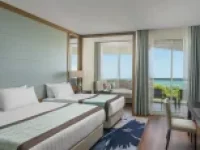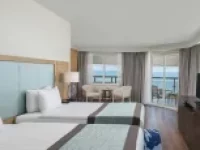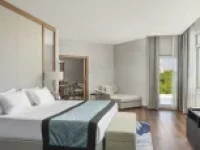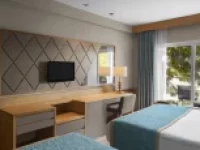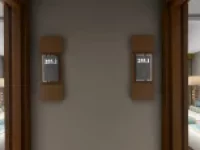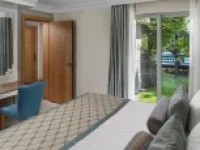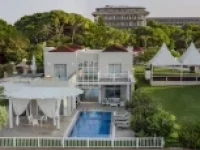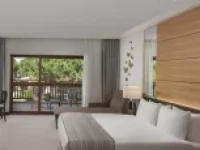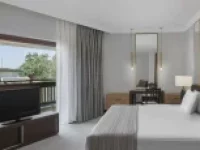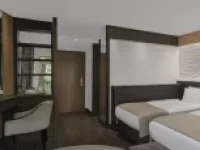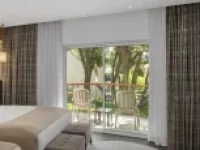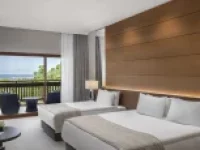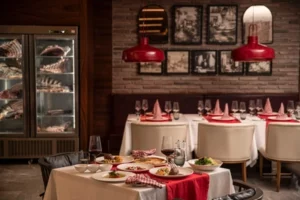Belek Villa Holiday at Papillon Ayscha
Villa holiday was a privilege for the elite in ancient times. Today it is a very accessible form of holiday for eanyone seeking an exclusive holiday together with their family. Now you can experience the pleasure of a contemporary 5-star villa holiday at Select Villa Suites of Papillon Ayscha. For those looking for a villa holiday in Belek, keep reading.
These days, you have the chance to experience the luxury of ancient times together with modern comfort at contemporary Select Villa Suites of Papillon Ayscha. Our Select Villa Suites are offering an exclusive Belek villa holiday among green pine trees, with fresh Mediterranean air and swimming pools that you dip into as soon as you walk out the door. In addition, the Select Villa Pool Bar located in the middle of clean and spacious pools will enhance your pool pleasure with soft drinks and snacks served all day long.
Furthermore, the expert staff at Papillon Ayscha will offer you special services in the spectacular villas. Our team that welcomes you at the entrance provides express check-in for your villa, serves breakfast into your room if you desire and offers 24-hour free room service.
Among many other services, unlimited and privileged reservation in all à la carte restaurants and discounts for your expenses within the facility are just a couple of the many advantages of a villa holiday in Papillon Ayscha.
If you are looking for the ideal villa holiday in Belek, book your place now for a pool right in front of your room just like the villas in ancient times, room service and many privileges. One of our 56 Select Villa Suites in Papillon Ayscha is ready for you, for sure!
Villas Since Ancient Times
“Villa”, historically, is the name given to the country houses in which the Roman Empire elite class resided especially in summer. Since cultivation was considered to be highly reputable in ancient Rome, having a farm in the countryside was a significant indicator of social status.
When the star Sirius, the brightest star in the Canis Major, appeared to rise just before the sun in Ancient Rome, “Dies Caniculare” (the dog days) would begin. This period corresponding to July-August means Siesta (Hora Sexta) for the public and travelling to villas for the elites in Ancient Rome.
In its early forms, villas first consisted of Villa Rustica for farmworkers and the comfortable Villa Urbana for the owner of the farm.
The Romans, with the expansion of the empire over the centuries, started to meet their needs with agricultural products that were imported from different geographies, from Egypt to the Black Sea. The villas lost their importance along with agriculture, becoming summer houses that were decorated with spectacular mosaics and pools. [1]
Unique mosaics that were unearthed in important Roman cities, such as Zeugma in Anatolia, decorated beautiful villas are exhibited in Gaziantep museum today. [2] Zeugma was an inspiration for Papillon Zeugma Relaxury, which features replicas of the many famous mosaics such as the “Gypsy Girl”.
Villa: Inviting Nature Inside
There were many luxuries to ensure the comfort of the elite in the villas, which turned from farmhouses to luxurious summer houses in ancient times. Villas had cool underground cellars to protect food and ventilation systems that circulated air in these cellars. For most elites, snow that remained in the peaks of the Alps until mid-summer was transported to the villa cellars with wagons and cold desserts, prepared with snow and honey, were offered to them.
Structures known as Otium Villas in modern literature, which invited the beautiful landscape inside with massive courtyards and gardens, were the best-known examples of this architecture. In this period, there were spectacular architectural elements, such as open courtyards, fountains, fish ponds, gardens, libraries, mosaic floors, fresco walls, underfloor heating, towers and artificial grottos. [1]
These spacious structures using an open-style architecture, usually built on terraced hills that let in fresh air, symbolised a lifestyle that was in direct opposition to crowded city life. As Vitruvius stated in his work “De Architectura”: “The villa is the opposite of a structure in a city. In the city, the structures try to leave out the city with all they have, whereas the villa, on the contrary, has been built to invite the beauty of nature inside.”
Belek Villa Holiday With 5-Star Hotel Comfort
Today, you do not need to bring snow down from mountain peaks or wear yourself out with the problems of a rental villa. You have the chance to experience the fresh air of the ancient villa, its architecture that invites nature inside and its superior service with the comfort of a 5-star hotel in Belek.
In Papillon Ayscha, you can have your breakfast without leaving your room and dip into a cool and clean pool in two steps, and get out of the pool and enjoy your drink at the Select Villa Pool Bar right next to your villa.
When you are hungry, you can either take your place at a private table reserved for you in the main restaurant or you can make unlimited reservations at any of our à la carte restaurants. Thereby, you can taste the flavours of the world’s different cuisines from the Far East to Mexico, Italy to Turkey from the hands of our master chefs every evening.
For a villa holiday in Belek, Select Villa Suites of Papillon Ayscha have been offering ideal conditions for your family and loved ones. Call our sales office today to book a villa with your loved ones in a special environment, far away from the crowds and noise of the city, just like in ancient times!
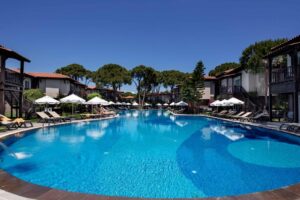
Did You Know?
- Dies Caniculare: The Latin origin of this concept is based on the rise of Sirius in Canis Major with the sun. The phrase “Dog days” in English and “Hundstage” in German is used to define the hottest days of summer when energy levels of people decrease, trade and everyday life slows down.
- Otium: The concept of “otium”, which can be defined as spending free time, was used in ancient Rome as leisure time, the opposite of the substantial activities of public life (negotium), and the retirement of a person after the previous service to the public or private sector. In literature, the first attested use of otium was in the Iphigenia poem of Quintus Ennius, who was regarded as the father of Ancient Roman poetry [3]: “He who knows not how to use leisure when there is leisure, in leisure has more work than he has in work when there is work.”
- Siesta (Hora Sexta/6th Hour): The “siesta”, which is still practised in Spain and some other countries, has its roots in ancient Rome. Since the hours in Rome were counted from dawn, noon corresponds to the sixth hour after dawn and so was named Hora Sexta. These hours are reserved for resting and “otium” especially in the Dies Caniculare period in Rome.
